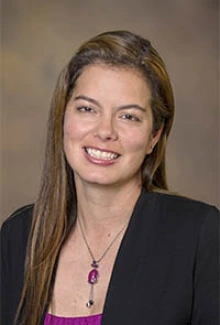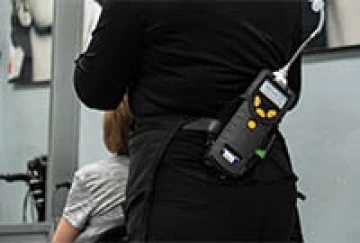Workplace Chemical Exposure Study Leads to Small Business COVID-19 Awareness Campaign
A public health research team is providing guidance to beauty, auto shop owners in Spanish-speaking areas to reduce COVID-19 infection risks.
TUCSON, Ariz. — Small business owners can take advantage of one-on-one training in preventing the spread of SARS-CoV-2, the virus that causes COVID-19, thanks to a project led by researchers at the University of Arizona Health Sciences in collaboration with the Sonora Environmental Resources Institute (SERI) and El Rio Health.

A summa cannistercollects air samples at a beauty salon. (Photo: Sonora Environmental Resources Institute Inc.)
The first training will take place during a Facebook Live event on Wednesday, Feb. 17, at 6:30 p.m. The Facebook Live event is open to any small business owner. SERI will host more Facebook Live events this spring, with additional outreach to include video chats and phone calls with tele-promotoras, or online community health workers.
“COVID-19 has amplified occupational health disparities, particularly in small businesses and communities of color,” said Paloma Beamer, PhD, associate professor of community, environment and policy at the UArizona Mel and Enid Zuckerman College of Public Health and a member of the BIO5 Institute. “Small businesses with LatinX workers are less likely to have access to health resources, including culturally and linguistically appropriate occupational health information and personal protective equipment, or PPE.”

Paloma Beamer, PhD, associate professor of public health, leads an NIH-funded studyon safe workplaces.(Photo: University of Arizona Health Sciences)
This public health partnership augments Dr. Beamer’s larger study, “El Trabajo No Te Debe Dañar: (Work Should Not Hurt You): Reduction of Hazardous Exposures in Small Businesses through a Community Health Worker Intervention,” which seeks to expand awareness of hazardous chemicals and ways to reduce workplace exposures via community health worker interventions, particularly in beauty and auto shops. Both projects are funded by the National Institute of Environmental Health Sciences, a unit of the National Institutes of Health.
Dr. Beamer said LatinX small business owners may feel greater economic pressure to stay open during the pandemic, but often lack the resources in Spanish to support their decisions. The research team found that making information easily available online in multiple languages often is the best way to reach those in need, because they can look it up on their smartphone, tablet or a computer. To that end, COVID-19 resources in English and Spanish are now available through a SERI webpage, which also provides information on the larger study.

Researchers use a photoionization detector, a type of gas detector, to check for volatile organic compounds at a salon. (Photo: Sonora Environmental Resources Institute Inc.)
“Our project will enhance our relationship with our small business partners by responding to their immediate needs during COVID-19 and help them throughout the crisis,” said SERI Program Director Flor Sandoval, who oversees the institute’s Pollution Prevention Program for Small Businesses. “With a community-engaged research approach, we will first promote worker safety by developing a novel ‘tele-promotora’ program to share occupational health information with our small business partners.”
In addition to their outreach efforts, researchers will assess competing risk perceptions of COVID-19 between small business owners and their staff, as well as economic impacts and hazards of volatile organic chemical (VOC) exposures from new disinfection protocols due to the pandemic.
Beauty salons and auto repair businesses may use workplace products – such as coloring dyes and nail polish, or paints, lubricants and degreasers – that increase workers’ exposures to hazardous solvents that include VOCs. Such exposures can lead to asthma, cardiovascular disease and cancer, which are risk factors for COVID-19 complications.
Part of the larger research project focuses on monitoring VOCs using stationary and mobile air sampling equipment. Researchers use the results to suggest airflow changes and other workplace protocols aimed at reducing exposures.

Prior to the COVID-19 pandemic,researchers from SERI and the UArizona Mel and Enid Zuckerman College of Public Healthvisited beauty salons in person to assess exposure risks.(Photo: Sonora Environmental Resources Institute Inc.)
The team recently published their first results in the journal BMC Public Health. In the paper, “Responsibility for chemical exposures: perspectives from small beauty salons and auto shops in southern metropolitan Tucson,” they noted that LatinX business owners and their staff may ignore risks of chemical exposures as a normal part of their workday due in part to vague or misleading product labels and instructions.
“Many times the businesses we’re working with are so small the owners are there in the shop working as much as the employees,” Dr. Beamer said. “They may have health effects that might be related to their job and that their doctors even told them about, but that’s their job and that’s how they make their livelihood. So, they’re going to keep doing it anyway.”
“The tele-promotora program will help increase our small business partner worker’s education, literacy and computer skills to understand workplace hazards and effective control options,” she added. “It will provide essential information about new VOC exposures and risk perceptions in the wake of COVID-19.”
Research reported in this publication was supported by the National Institute of Environmental Health Sciences, a unit of the National Institutes of Health (R01ES028250).
Contact
David Mogollon
mogollon@arizona.edu

